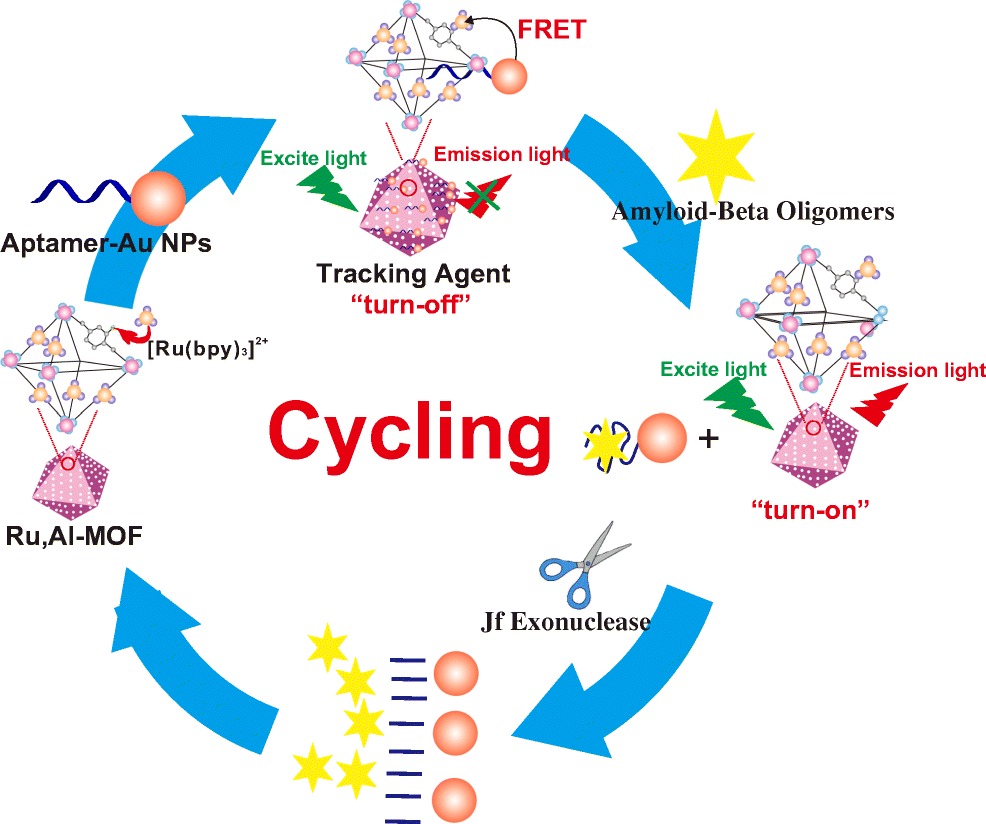当前位置:
X-MOL 学术
›
Microchim. Acta
›
论文详情
Our official English website, www.x-mol.net, welcomes your feedback! (Note: you will need to create a separate account there.)
An aptamer based fluorometric assay for amyloid-β oligomers using a metal-organic framework of type Ru@MIL-101(Al) and enzyme-assisted recycling
Microchimica Acta ( IF 5.7 ) Pub Date : 2020-01-09 , DOI: 10.1007/s00604-019-4092-3 Hong-Xia Ren, Yang-Bao Miao, Yuandong Zhang
Microchimica Acta ( IF 5.7 ) Pub Date : 2020-01-09 , DOI: 10.1007/s00604-019-4092-3 Hong-Xia Ren, Yang-Bao Miao, Yuandong Zhang

|
Amyloid-beta (Aβ) oligomers causing neuron damage are regarded as potential therapeutic targets and diagnostic markers for Alzheimer’s disease (AD). A homogeneous turn-on fluorometric aptasensor is described for Aβ oligomers. It is highly selective and non-invasive and based on (a) the use of a luminescent metal-organic framework carrying aptamer-modified AuNPs (L-MOF/Apt-Au) as tracking agent, and (b) enzyme-assisted target recycling signal amplification. The tracking agent does not emit fluoresce by fluorescence resonance energy transfer (FRET) between the luminescent MOF as donor and Apt-Au as the acceptor under the excitation wavelength of 466 nm. When Aβ oligomers are added to the tracking agent solution, the Apt-Au on tracking agent can preferentially bind with Aβ oligomers and then be released. This turns the “off” signal of the luminescent MOF tracer to the “on” state. The enzyme (Rec Jf exonuclease) added into the supernatant further improves sensitivity due to enzyme-assisted target-recycling signal amplification. The assay has an excellent linear response to Aβ oligomers from 1.0 pM to 10 nM, with a detection limit of 0.3 pM. This homogeneous turn-on fluorometric method is expected to have potential and applications in clinical diagnosis. Graphical abstract Schematic representation of fluorometric assay for amyloid-β oligomers based on luminescence metal-organic framework nanocomposites as tracking agent with exonuclease-assisted target recycling.
中文翻译:

使用 Ru@MIL-101(Al) 型金属有机骨架和酶辅助回收,基于适配体的淀粉样蛋白 β 寡聚体荧光测定
导致神经元损伤的淀粉样蛋白-β (Aβ) 寡聚体被认为是阿尔茨海默病 (AD) 的潜在治疗靶点和诊断标志物。描述了用于 Aβ 寡聚体的均质开启荧光适体传感器。它具有高度选择性和非侵入性,基于 (a) 使用带有适体修饰的 AuNPs (L-MOF/Apt-Au) 作为跟踪剂的发光金属有机框架,以及 (b) 酶辅助目标回收信号放大。在 466 nm 激发波长下,示踪剂不会通过作为供体的发光 MOF 和作为受体的 Apt-Au 之间的荧光共振能量转移 (FRET) 发出荧光。当 Aβ 寡聚体加入示踪剂溶液时,示踪剂上的 Apt-Au 可以优先与 Aβ 寡聚体结合,然后被释放。这将发光 MOF 示踪剂的“关闭”信号变为“开启”状态。添加到上清液中的酶(Rec Jf 核酸外切酶)由于酶辅助的目标再循环信号放大而进一步提高了灵敏度。该测定对 1.0 pM 至 10 nM 的 Aβ 寡聚体具有出色的线性响应,检测限为 0.3 pM。这种均相开启荧光测量方法有望在临床诊断中具有潜力和应用。基于发光金属-有机骨架纳米复合材料作为具有外切核酸酶辅助靶标回收的跟踪剂的淀粉样蛋白 β 寡聚体荧光测定的图形摘要示意图。该测定对 1.0 pM 至 10 nM 的 Aβ 寡聚体具有出色的线性响应,检测限为 0.3 pM。这种均相开启荧光测量方法有望在临床诊断中具有潜力和应用。基于发光金属-有机骨架纳米复合材料作为具有外切核酸酶辅助靶标回收的跟踪剂的淀粉样蛋白 β 寡聚体荧光测定的图形摘要示意图。该测定对 1.0 pM 至 10 nM 的 Aβ 寡聚体具有出色的线性响应,检测限为 0.3 pM。这种均相开启荧光测量方法有望在临床诊断中具有潜力和应用。基于发光金属-有机骨架纳米复合材料作为具有外切核酸酶辅助靶标回收的跟踪剂的淀粉样蛋白 β 寡聚体荧光测定的图形摘要示意图。
更新日期:2020-01-09
中文翻译:

使用 Ru@MIL-101(Al) 型金属有机骨架和酶辅助回收,基于适配体的淀粉样蛋白 β 寡聚体荧光测定
导致神经元损伤的淀粉样蛋白-β (Aβ) 寡聚体被认为是阿尔茨海默病 (AD) 的潜在治疗靶点和诊断标志物。描述了用于 Aβ 寡聚体的均质开启荧光适体传感器。它具有高度选择性和非侵入性,基于 (a) 使用带有适体修饰的 AuNPs (L-MOF/Apt-Au) 作为跟踪剂的发光金属有机框架,以及 (b) 酶辅助目标回收信号放大。在 466 nm 激发波长下,示踪剂不会通过作为供体的发光 MOF 和作为受体的 Apt-Au 之间的荧光共振能量转移 (FRET) 发出荧光。当 Aβ 寡聚体加入示踪剂溶液时,示踪剂上的 Apt-Au 可以优先与 Aβ 寡聚体结合,然后被释放。这将发光 MOF 示踪剂的“关闭”信号变为“开启”状态。添加到上清液中的酶(Rec Jf 核酸外切酶)由于酶辅助的目标再循环信号放大而进一步提高了灵敏度。该测定对 1.0 pM 至 10 nM 的 Aβ 寡聚体具有出色的线性响应,检测限为 0.3 pM。这种均相开启荧光测量方法有望在临床诊断中具有潜力和应用。基于发光金属-有机骨架纳米复合材料作为具有外切核酸酶辅助靶标回收的跟踪剂的淀粉样蛋白 β 寡聚体荧光测定的图形摘要示意图。该测定对 1.0 pM 至 10 nM 的 Aβ 寡聚体具有出色的线性响应,检测限为 0.3 pM。这种均相开启荧光测量方法有望在临床诊断中具有潜力和应用。基于发光金属-有机骨架纳米复合材料作为具有外切核酸酶辅助靶标回收的跟踪剂的淀粉样蛋白 β 寡聚体荧光测定的图形摘要示意图。该测定对 1.0 pM 至 10 nM 的 Aβ 寡聚体具有出色的线性响应,检测限为 0.3 pM。这种均相开启荧光测量方法有望在临床诊断中具有潜力和应用。基于发光金属-有机骨架纳米复合材料作为具有外切核酸酶辅助靶标回收的跟踪剂的淀粉样蛋白 β 寡聚体荧光测定的图形摘要示意图。



























 京公网安备 11010802027423号
京公网安备 11010802027423号